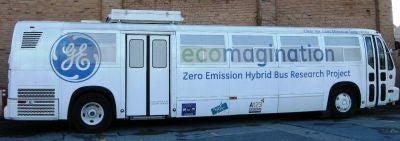General Electric (GE) has come up with a new electric bus prototype that it says has the potential to help battery-powered buses go mainstream.
The US energy giant revealed December 2 that it is working on a dual-battery system that can power heavy duty vehicles with zero emissions.
It says that by using a combination of a lithium battery and a sodium battery, it can create a power source that offers the driving range and acceleration requirements of large vehicles.
Its theory is based on the unique properties of the two types of battery - electric vehicles such as the Nissan Leaf and Mitsubishi i-MiEV use lithium batteries, which provide plenty of power for acceleration, but aren't very good at storing energy to provide a long range.
Sodium batteries are the opposite, providing range but less power, so researchers at General Electric have simply combined the two, creating a prototype that they believe could considerably cut public transport carbon outputs.
The firm estimates that many of the 843,000 buses in the US travel less than 100 miles (160 km) a day, a range that could be covered electrically without a leap in battery technology, as well as at a reduced cost.
Combining the best of both batteries would cost considerably less than scaling up a single battery system to get the same result, says GE.
Most green buses on the roads today either use biofuels or hybrid-electric technology rather than pure electricity (discounting those which operate using overhead power cables), although the hunt is on for a commercially viable electric bus.
Last year, Colorado company Proterra unveiled a new electric bus which used an advanced fast charge system to charge up in ten minutes, reportedly gaining interest from over 21 transit agencies around the world as of mid-2010.
See the electric bus in action: http://www.youtube.com/watch?v=qwQpLKTngTQ

Join our commenting forum
Join thought-provoking conversations, follow other Independent readers and see their replies
Comments